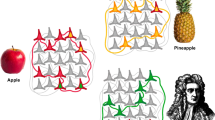Abstract
The ability to predict is the most importantability of the brain. Somehow, the cortex isable to extract regularities from theenvironment and use those regularities as abasis for prediction. This is a most remarkableskill, considering that behaviourallysignificant environmental regularities are noteasy to discern: they operate not only betweenpairs of simple environmental conditions, astraditional associationism has assumed, butamong complex functions of conditions that areorders of complexity removed from raw sensoryinputs. We propose that the brain's basicmechanism for discovering such complexregularities is implemented in the dendritictrees of individual pyramidal cells in thecerebral cortex. Pyramidal cells have 5–8principal dendrites, each of which is capableof learning nonlinear input-to-outputtransfer functions. We propose that eachdendrite is trained, in learning its transferfunction, by all the other principal dendritesof the same cell. These dendrites teach eachother to respond to their separate inputs withmatching outputs. Exposed to differentbut related information about the sensoryenvironment, principal dendrites of the samecell tune to functions over environmentalconditions that, while different, arecorrelated. As a result, the cell as awhole tunes to the source of the regularitiesdiscovered by the cooperating dendrites,creating a new representation. When organizedinto feed-forward/feedback layers, pyramidalcells can build their discoveries on thediscoveries of other cells, graduallyuncovering nature's hidden order. Theresulting associative network is powerfulenough to meet a troubling traditionalobjection to associationism: that it is toosimple an architecture to implement rationalprocesses.
Similar content being viewed by others
References
Abeles, M., 1991: Corticonics, Cambridge University Press, Cambridge.
Barlow, H.B., 1992: The biological role of neocortex, in A. Aertsen and V. Braitenberg (eds), Information Processing in the Cortex, Springer, Berlin, pp. 53-80.
Becker, S., 1995: JPMAX: Learning to recognize moving objects as a model-fitting problem, Advances in Neural Information Processing Systems 7, 933-940.
Becker, S., 1996: Mutual information maximization: Models of cortical self-organization, Network: Computation in Neural Systems 7, 7-31.
Becker, S., 1999: Implicit learning in 3D object recognition: The importance of temporal context, Neural Comp. 11, 347-374.
Becker, S. and Hinton, G.E., 1992: A self-organizing neural network that discovers surfaces in random-dot stereograms, Nature 355, 161-163.
Bienenstock, E.L., Cooper, L.N. and Munro, P.W., 1982: Theory for the development of neuron selectivity: Orientation specificity and binocular interaction in visual cortex, J. Neurosci. 2, 32-48.
Block, N., 1986: Advertisement for a semantics for psychology, Midwest Studies in Philosophy 10, 615-678.
Braitenberg, V., 1978: Cortical architectonics: General and areal, in M.A.B. Brazier and H. Petsch (eds), Architectonics of the Cerebral Cortex, Raven, Philadelphia.
Brooks, R., 1991: Intelligence without representation, Artif. Intell. 47, 139-159.
Burnod, Y., 1988: An Adaptive Neural Network: The Cerebral Cortex, Masson, Paris.
Carey, S., 1985: Conceptual Change in Childhood, MIT Press, Cambridge, MA.
Cauller, L., 1995: Layer I of primary sensory neocortex:Where top-down converges upon bottom-up, Behav. Brain Res. 71, 163-170.
Chalmers, D., 1996: The Conscious Mind: In Search of a Fundamental Theory, Oxford University Press, Oxford.
Clark, A. and Thornton, C., 1997: Trading places: Computation, representation, and the limits of uninformed learning, Behav. Brain Sci. 20, 57-90.
Dennett, D.C., 1994: The practical requirements for making a conscious robot, Philosophical Transactions of the Royal Society A349, 133-146.
Deuchars, J., West, D.C. and Thomson, A.M., 1994: Relationships between morphology and physiology of pyramid-pyramid single axon connections in rat neocortex in vitro, J. Physiol. (Lond.) 478, 423-435.
Dretske, F., 1981/ 1999: Knowledge and the Flow of Information, CSLI Publications, Stanford.
Dretske, F., 1988: Explaining Behavior, MIT Press, Cambridge, MA.
Edelman, G.M., 1987: Neural Darwinism: The Theory of Neuronal Group Selection, Basic Books, New York.
Favorov, O.V. and Kelly, D.G., 1996: Local receptive field diversity within cortical neuronal populations, in O. Franzen, R. Johansson and L. Terenius (eds), Somesthesis and the Neurobiology of the Somatosensory Cortex, Birkhauser, Basel, pp. 395-408.
Favorov, O.V., Ryder, D., Hester, J.T., Kelly, D.G. and Tommerdahl, M., 2001: The cortical pyramidal cell as a set of interacting error backpropagating dendrites: A mechanism for discovering nature's order, in R. Hecht-Nielsen and T. McKenna (eds), Theories of the Cerebral Cortex, Springer-Verlag, Berlin, in press.
Feldman, M.L., 1984: Morphology of the neocortical pyramidal neuron, in A. Peters and E.G. Jones (eds), Cerebral Cortex, vol. 1, Plenum Press, New York, pp. 123-200.
Fodor, J.A., 1983: Modularity of Mind, MIT Press, Cambridge, MA.
Fodor, J., 1987: Psychosemantics, MIT Press, Cambridge, MA.
Fodor, J., 1998: Concepts: Where Cognitive Science Went Wrong, Oxford University Press, Oxford.
Fodor, J.A. and Pylysyn, Z., 1988: Connectionism and cognitive architecture: A critical analysis, Cognition 28, 3-72.
Gawne, T.J., Kjaer, T.W., Hertz, J.A. and Richmond, B.J., 1996: Adjacent visual cortical complex cells share about 20% of their stimulus-related information, Cereb. Cortex 6, 482-489.
Gelman, S.A. and Coley, J.D., 1991: Language and categorization: The acquisition of natural kind terms, in S.A. Gelman and J.P. Byrnes (eds), Perspectives on Language and Thought, Cambridge University Press, Cambridge.
Grossberg, S., 1974: Classical and instrumental learning by neural networks, Progress in Theoretical Biology 3, 51-141.
Grossberg, S., 2000: The complementary brain: Unifying brain dynamics and modularity, Trends in Cognitive Sciences 4, 233-246.
Hancock, P.J.B., Smith, L.S. and Phillips, W.A., 1991: A biologically supported error-correcting learning rule, Neural Comp. 3, 201-212.
Hartley, D., 1749/1970: Observations on Man, selections in Robert Brown (ed.), Between Hume and Mill: An Anthology of British Philosophy 1749-1843, Random House, New York.
Hume, D., 1740/1978: A Treatise of Human Nature, in L.A. Selby-Bigge (ed.), Oxford University Press, Oxford.
Jackson, F., 1998: From Metaphysics to Ethics: A Defence of Conceptual Analysis, Oxford University Press, Oxford.
Johnston, D., Hoffman, D.A., Colbert, C. M. and Magee, J.C., 1999: Regulation of back-propagating action potentials in hippocampal neurons, Curr. Opin. Neurobiol. 9, 288-292.
Kant, I., 1787/1996: Critique of Pure Reason, Hackett, Indianapolis.
Katz, J., 1972: Semantic Theory, Harper & Row, New York.
Kripke, S., 1972/ 1980: Naming and Necessity, Blackwell, Oxford.
Lettvin, J., 1988: Forward to W.S. McCulloch, Embodiments of Mind, MIT Press, Cambridge, Mass.
Lycan, W.G., 2000: Philosophy of Language, Routledge, London.
Magee, J.C. and Johnston, D., 1997: A synaptically controlled, associative signal for Hebbian plasticity in hippocampal neurons, Science 275, 209-213.
Malach, R., 1994: Cortical columns as devices for maximizing neuronal diversity, TINS 17, 101-104.
Malinow, R., Mainen, Z.F. and Hayashi, Y., 2000: LTP mechanisms: From silence to four-lane traffic, Curr. Opin. Neurobiol. 10, 352-357.
Markram, H., Lubke, J., Frotscher, M., Roth, A. and Sakmann, B., 1997a: Physiology and anatomy of synaptic connections between thick tufted pyramidal neurones in the developing rat neocortex, J. Physiol. (Lond.) 500, 409-440.
Markram, H., Lubke, J., Frotscher, M. and Sakmann, B., 1997b: Regulation of synaptic efficacy by coincidence of postsynaptic APs and EPSPs, Science 275, 213-215.
Markram, H., Pikus, D., Gupta, A. and Tsodyks, M., 1998: Potential for multiple mechanisms, phenomena and algorithms for synaptic plasticity at single synapses. Neuropharmacology 37, 489-500.
McGuire, B., Gilbert, C.D., Wiesel, T.N. and Rivlin, P.K., 1991: Targets of horizontal connections in macaque primary visual cortex, J. Comp. Neurol. 305, 370-392.
Mel, B.W., 1994: Information processing in dendritic trees, Neural Comp. 6, 1031-1085.
Millikan, R., 1999: A common structure for concepts of individuals, stuffs, and real kinds: More mama, more milk, and more mouse, in in E. Margolis and S. Laurence (eds), Concepts: Core Readings, MIT Press, Cambridge, MA, pp. 525-547.
Minsky, M. and Papert, S., 1988: Perceptrons, 3rd edition, MIT Press, Cambridge, MA.
Mountcastle, V.B., 1978: An organizing principle for cerebral function, in G.M. Edelman and V.B. Mountcastle (eds), The Mindful Brain, MIT Press, Cambridge, MA, pp. 7-50.
Murphy, G., and Medin, D., 1985: The role of theories in conceptual coherence, Psych. Rev. 92, 289-316.
Paulsen, O. and Sejnowski, T.J., 2000: Natural patterns of activity and long-term synaptic plasticity, Curr. Opinion Neurobiol. 10, 172-179.
Peacocke, C., 1992: A Study of Concepts, MIT Press, Cambridge, MA.
Phillips, W.A. and Singer, W., 1997: In search of common foundations for cortical computation, Behav. Brain Sci. 20, 657-722.
Pinker, S., 1997: How the Mind Works, W.H. Norton, New York.
Putnam, H., 1975: The Meaning of ‘Meaning’, in K. Gunderson (ed.), Language, Mind and Knowledge, Minnesota Studies in Philosophy of Science vol. 7, University of Minnesota, Minneapolis.
Quartz, S.R. and Sejnowski, T.J., 1997: The neural basis of cognitive development: A constructivist manifesto, Behav. Brain Sci. 20, 537-596.
Quine, W., 1953: Two Dogmas of Empiricism, in From a Logical Point of View, Harvard University Press, Cambridge, MA, pp. 20-46.
Rey, G., 1997: Contemporary Philosophy of Mind, Blackwell, Oxford.
Rosch, E. and Mervis, C., 1975: Family Resemlances: Studies in the internal structure of categories, Cogn. Psych. 7, 573-605.
Rosenberg, J.R., 1997: Connectionism and cognition, in J. Haugeland (ed.), Mind Design II, MIT Press, Cambridge, MA, pp. 293-308.
Rumelhart, D.E., Hinton, G.E. and Williams, R.J., 1986: Learning internal representations by error propagation, in D.E. Rumelhart, J.L. McClelland and PDP Research Group (eds), Parallel Distributed Processing: Explorations in the Microstructure of Cognition, MIT Press, Cambridge, MA, vol. 1, pp. 318-362.
Russell, B., 1914/ 1993: Our Knowledge of the External World, Routledge, London.
Schuz, A., 1992: Randomness and constraints in the cortical neuropil, in A. Aertsen and V. Braitenberg (eds), Information Processing in the Cortex, Springer, Berlin, pp. 3-21.
Segev, I., Fleshman, J.W. and Burke, R.E., 1989: Compartmental models of complex neurons, in C. Koch and I. Segev (eds), Methods in Neuronal Modeling, MIT Press, Cambridge,MA, pp. 63-96.
Sejnowski, T.J., 1977: Storing covariance with nonlinearly interacting neurons, J. Math. Biol. 4, 303-321.
Singer, W., 1995: Development and plasticity of cortical processing architectures, Science 270, 758-764.
Smith, E. and Medin, D., 1981: Categories and Concepts, Harvard University Press, Cambridge, MA.
Spruston, N., Schiller, Y., Stuart, G. and Sakmann, B., 1995: Activity-dependent action potential invasion and calcium influx into hippocampal CA1 dendrites, Science 268, 297-300.
Stroud, B., 1977: Hume, Routledge, London.
Stuart, G., Spruston, N., Sakmann, B. and Hausser, M., 1997: Action potential initiation and backpropagation in neurons of the mammalian CNS, TINS 20, 125-131.
Svoboda, K., Denk, W., Kleinfeld, D. and Tank, D., 1997: In vivodendritic calcium dynamics in neocortical pyramidal neurons, Nature 385, 161-163.
Thomson, A.M. and Deuchars, J., 1994: Temporal and spatial properties of local circuits in neocortex, TINS 17, 119-126.
Willshaw, D.J. and Dayan, P., 1990: Optimal plasticity from matrix memories: What goes up must come down, Neural Comp. 2, 85-93.
Author information
Authors and Affiliations
Rights and permissions
About this article
Cite this article
Ryder, D., Favorov, O.V. The New Associationism: A Neural Explanation for the Predictive Powers of Cerebral Cortex. Brain and Mind 2, 161–194 (2001). https://doi.org/10.1023/A:1012296506279
Issue Date:
DOI: https://doi.org/10.1023/A:1012296506279




